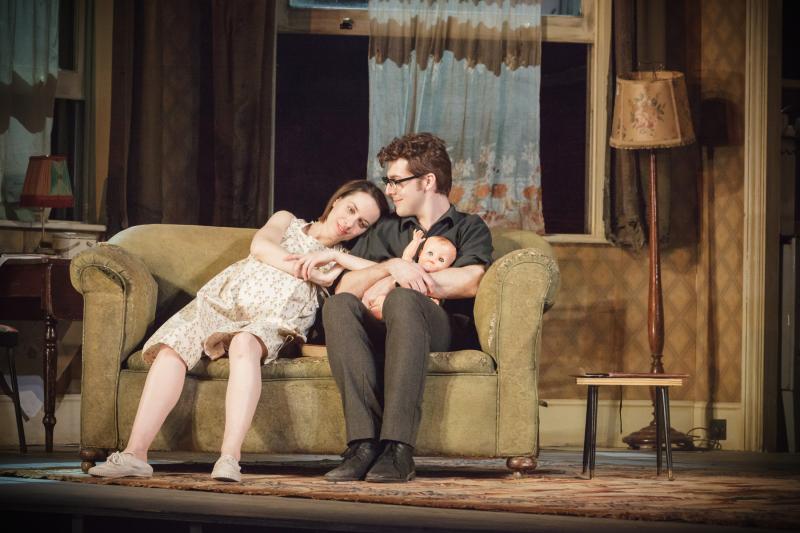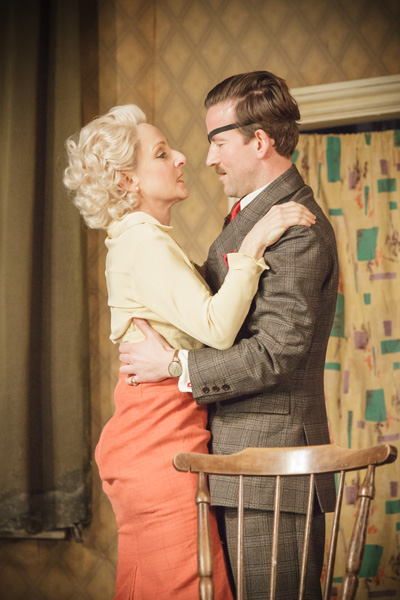A Taste of Honey, National Theatre | reviews, news & interviews
A Taste of Honey, National Theatre
A Taste of Honey, National Theatre
New staging of Shelagh Delaney’s 1958 play is more vivid cartoon than reimagined classic

Another week, another postwar classic. Hot on the heels of last week’s revival of Oh What a Lovely War comes another legendary play from the Joan Littlewood museum of great one-offs. This time it’s a restaging of Shelagh Delaney’s 1958 play about poor parenting and teen pregnancy in Salford.
The original play was penned by Delaney when, as a 19-year-old Salford teenager, she saw a production of Terence Rattigan’s Variation on a Theme on tour in Manchester. She was so incensed about its mealy-mouthed portrayal of homosexuality that she determined to write a realistic account of sexuality, and of real life. Hence the story of Jo, the young daughter of the single mother Helen, her pregnancy following a brief encounter with a black sailor, and her co-habitation with Geof, a young gay art student.
A shabby flat appears in all its hyper-realistic glory
Of course, in the hands of Littlewood, the piece’s original director, this slice of life became embellished with several theatrical devices, such as direct address to the audience and the presence on stage of a live jazz band. How does its current director director, Bijan Sheibani, tackle the challenge of re-imaging the play for an audience of today? At first, the signs are not good. Hildegard Bechtler’s huge set lumbers into view, a sunless Coronation Street monstrosity, all sooty tenements and scrubbed doorsteps.
Then this revolves and a shabby flat appears in all its hyper-realistic glory — you can almost see the mould growing in the corners and smell the grease from the blocked kitchen sink. Such high-definition grimness feels much too rich for the play, and Delaney’s young voice struggles to be heard amid the peroxide hair-do's, glittering high-heels and assorted 1950s glam. This is not naturalism so much as cartoon caricature; not stripped back poverty, but hugely expensive stage and costume effects. Yes, we're in a theatre museum. Except that this time there's no onstage jazz band and precious little direct address to the audience.
 Battling gamely against the massy impressiveness of the design is the cast, led by the wonderful Lesley Sharp as Helen and the magnetic Kate O’Flynn as Jo. If the first round goes to the surroundings, gradually these two women make their mark. Sharp grows from being a battered fortysomething with a dripping nose into a woman suddenly rejuvenated by the prospect of another marriage, while O’Flynn starts off as a vulnerable child and develops into a confident young woman. Good support comes from Dean Lennox Kelly as Peter (pictured right with Sharp), Helen’s smarmy new beau, and Harry Hepple as the earnest and sensitive Geof.
Battling gamely against the massy impressiveness of the design is the cast, led by the wonderful Lesley Sharp as Helen and the magnetic Kate O’Flynn as Jo. If the first round goes to the surroundings, gradually these two women make their mark. Sharp grows from being a battered fortysomething with a dripping nose into a woman suddenly rejuvenated by the prospect of another marriage, while O’Flynn starts off as a vulnerable child and develops into a confident young woman. Good support comes from Dean Lennox Kelly as Peter (pictured right with Sharp), Helen’s smarmy new beau, and Harry Hepple as the earnest and sensitive Geof.
But the most tender moments are those when Jo has a tryst with Jimmie, played by Eric Kofi Abrefa, the black sailor who gets her pregnant and then ships out. Suddenly you forget about the overpowering set, and instead you thrill to the sympathetic vibes between the actors. The same is true in much of the second half in the gentle domestic banter between Jo and Geof, soon to be rudely interrupted by the domineering Helen.
But such episodes of emotional truth are often compromised by Sheibani’s love of comedy, with distractingly funny dancing during the scene changes, and a tendency to prefer grotesque caricature to real-life honesty. Sadly, in this production the pathos is never deep enough to balance the jokiness — and the lasting impression of a lurid cartoon of northern working-class life is extremely hard to shake off. What this play needs is more simplicity, less art.
rating
Buy
Explore topics
Share this article
The future of Arts Journalism
You can stop theartsdesk.com closing!
We urgently need financing to survive. Our fundraising drive has thus far raised £49,000 but we need to reach £100,000 or we will be forced to close. Please contribute here: https://gofund.me/c3f6033d
And if you can forward this information to anyone who might assist, we’d be grateful.

Subscribe to theartsdesk.com
Thank you for continuing to read our work on theartsdesk.com. For unlimited access to every article in its entirety, including our archive of more than 15,000 pieces, we're asking for £5 per month or £40 per year. We feel it's a very good deal, and hope you do too.
To take a subscription now simply click here.
And if you're looking for that extra gift for a friend or family member, why not treat them to a theartsdesk.com gift subscription?
more Theatre
 The Line of Beauty, Almeida Theatre review - the 80s revisited in theatrically ravishing form
Alan Hollinghurst novel is cunningly filleted, very finely acted
The Line of Beauty, Almeida Theatre review - the 80s revisited in theatrically ravishing form
Alan Hollinghurst novel is cunningly filleted, very finely acted
 Wendy & Peter Pan, Barbican Theatre review - mixed bag of panto and comic play, turned up to 11
The RSC adaptation is aimed at children, though all will thrill to its spectacle
Wendy & Peter Pan, Barbican Theatre review - mixed bag of panto and comic play, turned up to 11
The RSC adaptation is aimed at children, though all will thrill to its spectacle
 Hedda, Orange Tree Theatre review - a monument reimagined, perhaps even improved
Scandinavian masterpiece transplanted into a London reeling from the ravages of war
Hedda, Orange Tree Theatre review - a monument reimagined, perhaps even improved
Scandinavian masterpiece transplanted into a London reeling from the ravages of war
 The Assembled Parties, Hampstead review - a rarity, a well-made play delivered straight
Witty but poignant tribute to the strength of family ties as all around disintegrates
The Assembled Parties, Hampstead review - a rarity, a well-made play delivered straight
Witty but poignant tribute to the strength of family ties as all around disintegrates
 Mary Page Marlowe, Old Vic review - a starry portrait of a splintered life
Tracy Letts's Off Broadway play makes a shimmeringly powerful London debut
Mary Page Marlowe, Old Vic review - a starry portrait of a splintered life
Tracy Letts's Off Broadway play makes a shimmeringly powerful London debut
 Little Brother, Soho Theatre review - light, bright but emotionally true
This Verity Bargate Award-winning dramedy is entertaining as well as thought provoking
Little Brother, Soho Theatre review - light, bright but emotionally true
This Verity Bargate Award-winning dramedy is entertaining as well as thought provoking
 The Unbelievers, Royal Court Theatre - grimly compelling, powerfully performed
Nick Payne's new play is amongst his best
The Unbelievers, Royal Court Theatre - grimly compelling, powerfully performed
Nick Payne's new play is amongst his best
 The Maids, Donmar Warehouse review - vibrant cast lost in a spectacular-looking fever dream
Kip Williams revises Genet, with little gained in the update except eye-popping visuals
The Maids, Donmar Warehouse review - vibrant cast lost in a spectacular-looking fever dream
Kip Williams revises Genet, with little gained in the update except eye-popping visuals
 Ragdoll, Jermyn Street Theatre review - compelling and emotionally truthful
Katherine Moar returns with a Patty Hearst-inspired follow up to her debut hit 'Farm Hall'
Ragdoll, Jermyn Street Theatre review - compelling and emotionally truthful
Katherine Moar returns with a Patty Hearst-inspired follow up to her debut hit 'Farm Hall'
 Troilus and Cressida, Globe Theatre review - a 'problem play' with added problems
Raucous and carnivalesque, but also ugly and incomprehensible
Troilus and Cressida, Globe Theatre review - a 'problem play' with added problems
Raucous and carnivalesque, but also ugly and incomprehensible
 Clarkston, Trafalgar Theatre review - two lads on a road to nowhere
Netflix star, Joe Locke, is the selling point of a production that needs one
Clarkston, Trafalgar Theatre review - two lads on a road to nowhere
Netflix star, Joe Locke, is the selling point of a production that needs one
 Ghost Stories, Peacock Theatre review - spirited staging but short on scares
Impressive spectacle saves an ageing show in an unsuitable venue
Ghost Stories, Peacock Theatre review - spirited staging but short on scares
Impressive spectacle saves an ageing show in an unsuitable venue

Add comment